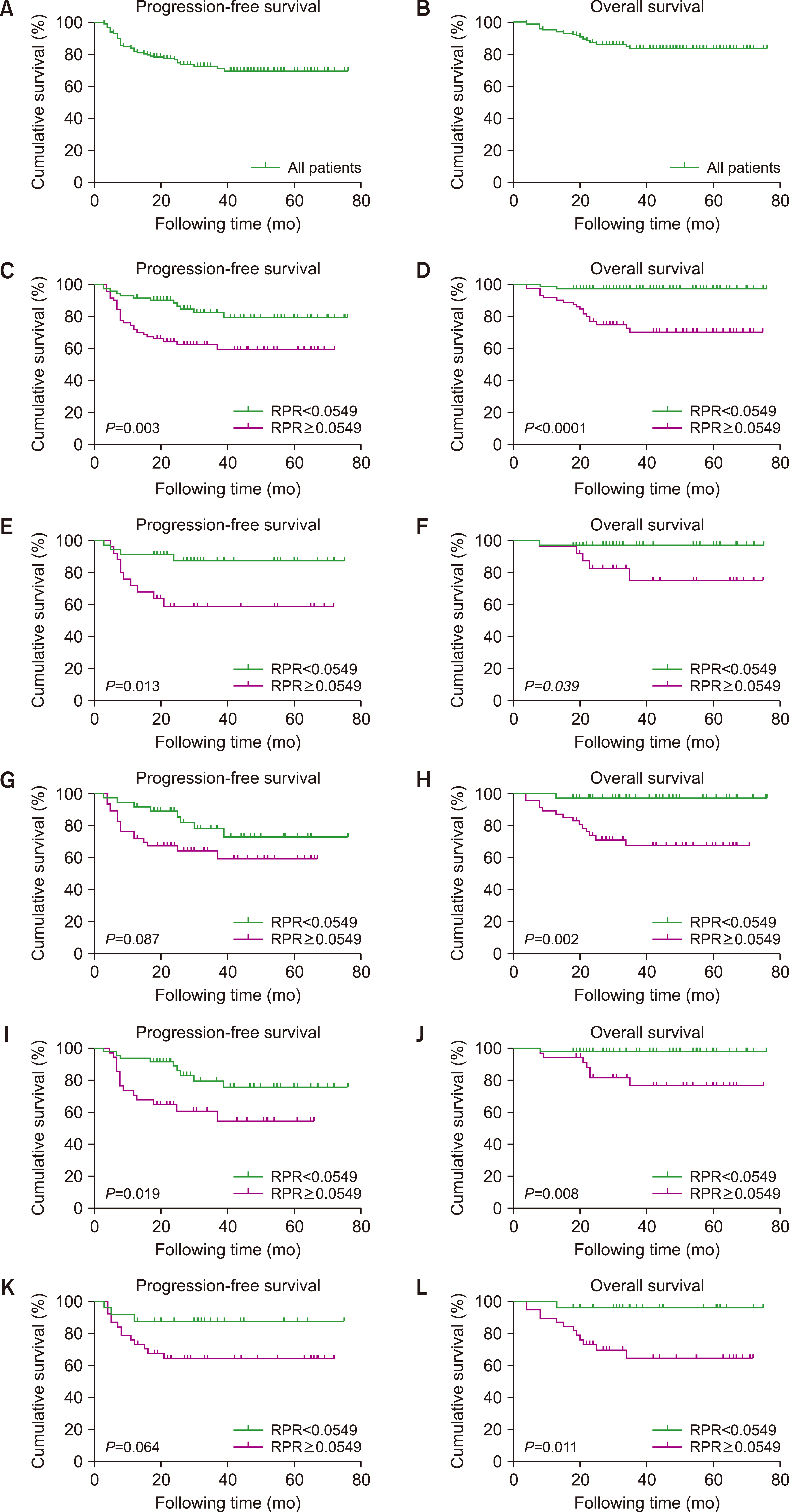2. Zhou Z, Sehn LH, Rademaker AW, et al. 2014; An enhanced Inter-national Prognostic Index (NCCN-IPI) for patients with diffuse large B-cell lymphoma treated in the rituximab era. Blood. 123:837–42. DOI:
10.1182/blood-2013-09-524108. PMID:
24264230. PMCID:
PMC5527396.
3. Chaganti S, Illidge T, Barrington S, et al. 2016; Guidelines for the management of diffuse large B-cell lymphoma. Br J Haematol. 174:43–56. DOI:
10.1111/bjh.14136. PMID:
27196701.
5. Zhao P, Zang L, Zhang X, et al. 2017; The lymphocyte-monocyte ratio and the platelet-lymphocyte ratio at diagnosis as independent prognostic factors in primary gastrointestinal diffuse large B cell lymphoma. Indian J Hematol Blood Transfus. 33:333–41. DOI:
10.1007/s12288-016-0720-9. PMID:
28824234. PMCID:
PMC5544629.
7. Chen H, Qin Y, Yang J, et al. 2021; The pretreatment platelet count predicts survival outcomes of diffuse large B-cell lymphoma: an analysis of 1007 patients in the rituximab era. Leuk Res. 110:106715. DOI:
10.1016/j.leukres.2021.106715. PMID:
34598076.
8. Zhou S, Ma Y, Shi Y, et al. 2018; Mean platelet volume predicts prognosis in patients with diffuse large B-cell lymphoma. Hematol Oncol. 36:104–9. DOI:
10.1002/hon.2467. PMID:
28736928.
9. Schneider M, Schäfer N, Apallas S, et al. 2021; Red blood cell distribution width to platelet ratio substantiates preoperative survival prediction in patients with newly-diagnosed glioblastoma. J Neurooncol. 154:229–35. DOI:
10.1007/s11060-021-03817-4. PMID:
34347223. PMCID:
PMC8437903.
10. Cetinkaya E, Senol K, Saylam B, Tez M. 2014; Red cell distribution width to platelet ratio: new and promising prognostic marker in acute pancreatitis. World J Gastroenterol. 20:14450–4. DOI:
10.3748/wjg.v20.i39.14450. PMID:
25339831. PMCID:
PMC4202373.
11. Takeuchi H, Abe M, Takumi Y, et al. 2019; Elevated red cell distribution width to platelet count ratio predicts poor prognosis in patients with breast cancer. Sci Rep. 9:3033. DOI:
10.1038/s41598-019-40024-8. PMID:
30816333. PMCID:
PMC6395769.
12. Li M, Bai Y, Sun X, et al. 2023; High red blood cell distribution width to platelet ratio is an independent poor prognostic factor in patients with newly diagnosed multiple myeloma. Discov Med. 35:157–67. DOI:
10.24976/Discov.Med.202335175.16. PMID:
37105925.
14. Periša V, Zibar L, Sinčić-Petričević J, Knezović A, Periša I, Barbić J. 2015; Red blood cell distribution width as a simple negative prognostic factor in patients with diffuse large B-cell lymphoma: a retro-spective study. Croat Med J. 56:334–43. DOI:
10.3325/cmj.2015.56.334. PMID:
26321026. PMCID:
PMC4576747.
15. Wei TT, Wang LL, Yin JR, et al. 2017; Relationship between red blood cell distribution width, bilirubin, and clinical characteristics of patients with gastric cancer. Int J Lab Hematol. 39:497–501. DOI:
10.1111/ijlh.12675. PMID:
28497572.
16. Wang J, Xie X, Cheng F, et al. 2017; Evaluation of pretreatment red cell distribution width in patients with multiple myeloma. Cancer Biomark. 20:267–72. DOI:
10.3233/CBM-170032. PMID:
28826172.
17. Salvagno GL, Sanchis-Gomar F, Picanza A, Lippi G. 2015; Red blood cell distribution width: a simple parameter with multiple clinical applications. Crit Rev Clin Lab Sci. 52:86–105. DOI:
10.3109/10408363.2014.992064. PMID:
25535770.
18. Beltran BE, Paredes S, Castro D, Cotrina E, Sotomayor EM, Castillo JJ. 2019; High red cell distribution width is an adverse predictive and prognostic factor in patients with diffuse large B-cell lymphoma treated with chemoimmunotherapy. Clin Lymphoma Myeloma Leuk. 19:e551–7. DOI:
10.1016/j.clml.2019.06.005. PMID:
31320254.
20. Bloomfield CD, McKenna RW, Brunning RD. 1976; Significance of haematological parameters in the non-Hodgkin's malignant lymphomas. Br J Haematol. 32:41–6. DOI:
10.1111/j.1365-2141.1976.tb01873.x. PMID:
1259924.
22. Bilgin B, Sendur MAN, Hizal M, et al. 2019; Prognostic effect of red cell distribution width-to-platelet ratio in colorectal cancer according to tumor stage and localization. J Cancer Res Ther. 15:54–60. DOI:
10.4103/jcrt.JCRT_624_17. PMID:
30880755.
23. Hans CP, Weisenburger DD, Greiner TC, et al. 2004; Confirmation of the molecular classification of diffuse large B-cell lymphoma by immunohistochemistry using a tissue microarray. Blood. 103:275–82. DOI:
10.1182/blood-2003-05-1545. PMID:
14504078.
24. Boltežar L, Prevodnik VK, Perme MP, Gašljević G, Novaković BJ. 2018; Comparison of the algorithms classifying the ABC and GCB subtypes in diffuse large B-cell lymphoma. Oncol Lett. 15:6903–12. DOI:
10.3892/ol.2018.8243. PMID:
29731865. PMCID:
PMC5921237.





 PDF
PDF Citation
Citation Print
Print


 XML Download
XML Download